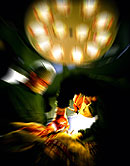 |
 |
 |

Doctors Describe First U.S. Face Transplant
22-hour procedure replaced 80% of severely disfigured woman's face, physicians say|
|
HealthDay
Wednesday, December 17, 2008
 WEDNESDAY, Dec. 17 (HealthDay News) -- A team of eight Cleveland Clinic surgeons has completed the nation's first near-total face transplant.
WEDNESDAY, Dec. 17 (HealthDay News) -- A team of eight Cleveland Clinic surgeons has completed the nation's first near-total face transplant.
Surgeons replaced most of the woman's face, including about 80 percent of the skin surface of her face, total nose, most of the sinuses, upper jaw -- essentially everything except the upper eyelids, forehead, lower lip and chin -- with that of a deceased donor in an immensely complex procedure taking place just weeks ago.
"We have finally done it," said Dr. Maria Siemionow, director of plastic surgery research and head of microsurgery training at the Cleveland Clinic, who led the team. "This procedure went well according to the plan, and the patient is doing well. The surgery took 22 hours. The preparation to the surgery took about 20 years of work in the field of composite tissue transplantation."
Siemionow and other members of the team spoke at a Wednesday teleconference, punctuated by thunderous applause from the audience and pleas from members of the surgical team to respect the privacy of the recipient and the donor.
The patient, identified only as a female and a U.S. citizen, had suffered a major facial trauma in the middle of her face so that multiple parts of her face were missing, including skin, bone, nose, eyelids, upper lid, right eye. She could not smell and had trouble speaking and could not eat or breathe without a tracheostomy.
"She was really suffering whenever she appeared in a social situation, was called names, children were afraid of her, were running away. The patient was brave, and she was very stable and facing the world. However, it became very difficult for her just to go outside of her house," Siemionow said.
Doctors would not disclose what kind of trauma was responsible for the disfigurement, only that the patient had exhausted all existing, conventional procedures, a condition for eligibility for the rare procedure.
Although this is the first such procedure in the U.S., 38-year-old Isabelle Dinoire successfully underwent a partial-face transplant in France in 2005, after being mauled by her dog. Since then, two other face grafts have been performed, one in China in 2006 and another in Europe in 2007.
At the Wednesday press conference, Cleveland Clinic bioethicist Dr. Eric Kodish stressed that the patient, considered to be a participant in human subjects research, was "appropriately protected."
"We believe the ethical basis for this endeavor is beyond reproach," he said. "We can anticipate that some may be concerned that this will be used as a means of identity transfer or as a cosmetic technique. We will do the best to prevent this from happening and we believe society can reach consensus and put safeguards in place to prevent that. This must be limited to the medical context, and we do not think this should be used for cosmetic enhancement."
"This is not cosmetic surgery in any conventional sense," he continued. "The face is the physical embodiment of a person's identity, and human beings are inherently social creatures. A person who has sustained a trauma or other devastation to the face is generally isolated and suffers tremendously. The damage to quality of life cannot even be put into words."
The Clinic's Institutional Review Board approved the surgery in late 2004.
The sequence of events leading to the face transplant began in the middle of the night several weeks ago when Francis Papay, chairman of the clinic's dermatology and plastic surgery institute, received an phone call telling of a potential donor.
Other members of the already assembled surgical team were immediately contacted through a sort of "phone tree," then waited throughout the night to confirm the donor was a match.
Surgery began at 5:30 p.m. with specialists making sure the recipient's neck, which had already undergone multiple surgeries, would allow the procedure to continue. At just after five in the morning, the donor's facial tissue was brought to the recipient and, for the next 11 hours, the surgical team worked to connect the new tissue to the recipient.
The surgery was complete by 4:30 p.m. The recipient is still at the hospital and is taking immune-suppressive drugs but has shown no signs of rejection.
The patient, who will look neither like herself or the donor, has not yet seen her new visage but has felt it with her hands. "I must tell you how happy she was when we brought her hands to her face and she could feel she has a jaw, has a nose, has a full face in front of her," Siemionow said. "When the swelling goes down, she will be able to recognize her face."
"Our hope is that once the facial nerve is connected and grows through, that she can smile again," Papay added.
Dr. Risal Djohan, a plastic surgeon and another member of the team, read a letter from one of the woman's siblings. "We never thought for a moment our sister would ever have a chance at a normal life again," the missive read. "But thanks to the wonderful person who donated herself to help another, now she has a chance to live a normal life."
HealthDay
Copyright (c) 2008 ScoutNews, LLC. All rights reserved.
More News on this Date
| Home | Health Topics | Drugs & Supplements | Encyclopedia | Dictionary | News | Directories | Other Resources | |
| Disclaimers | Copyright | Privacy | Accessibility | Quality Guidelines U.S. National Library of Medicine, 8600 Rockville Pike, Bethesda, MD 20894 National Institutes of Health | Department of Health & Human Services |
Date last updated: 18 December 2008 |




